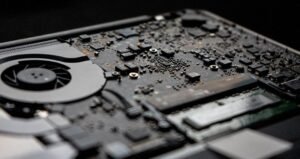Tesla Autopilot
The Tesla Autopilot system is an advanced driver-assistance feature available in Tesla vehicles. It utilizes a combination of sensors, cameras, and artificial intelligence to assist with various driving tasks.
Key Takeaways
- Tesla Autopilot is an advanced driver-assistance system present in Tesla vehicles.
- It uses sensors, cameras, and AI to assist with driving tasks.
- The system is continually improving through software updates.
- Drivers are still responsible for staying attentive and ready to take control.
- Autopilot enhances safety and convenience on the road.
**Tesla Autopilot** employs a suite of sensors and cameras to detect and interpret its surroundings. These include forward-facing cameras, radar sensors, ultrasonic sensors, and a GPS system. By continuously gathering and analyzing data, the Autopilot system can make decisions based on real-time information, helping the vehicle navigate and respond to its environment.
One interesting fact about Tesla Autopilot is that it can recognize and respond to traffic lights and stop signs. Using its cameras and sensors, the system can detect these important traffic control devices and assist the driver in navigating intersections safely.
Autopilot Features
The Tesla Autopilot system offers a range of features that contribute to its advanced functionality:
- **Traffic-Aware Cruise Control (TACC)**: This feature enables the vehicle to maintain a safe distance from the vehicle ahead, automatically adjusting its speed as necessary.
- **Autosteer**: With this feature, the vehicle can stay within its lane, even around curves, by automatically controlling the steering.
- **Auto Lane Change**: Autopilot can change lanes when requested by the driver, after checking for safe conditions.
- **Autopark**: This feature assists with parallel and perpendicular parking, using the vehicle’s sensors to guide it into parking spaces.
- **Summon**: With the Summon feature, the vehicle can autonomously park itself or come to the driver from a parking space.
| Statistic | Autopilot Engaged | Autopilot Off |
|---|---|---|
| Fatal Accidents per Mile | 1 in 320 million miles | 1 in 86 million miles |
| Accidents involving Injury per Mile | 1 in 7.38 million miles | 1 in 2.87 million miles |
Tesla has been collecting data from its vehicles on real-world driving scenarios, enabling them to continually improve the Autopilot system. Software updates provide regular enhancements and improvements to the functionality and safety of the system.
**It is important to note that while Autopilot offers advanced driving assistance**, it does not make the vehicle fully autonomous. The driver is responsible for remaining attentive and keeping their hands on the steering wheel, ready to take control if necessary.
The Future of Autopilot
Tesla continues to refine and expand its Autopilot feature with the goal of achieving full self-driving capabilities in the future. The company is working to enhance the system’s capabilities and improve safety even further.
| Version | Release Date |
|---|---|
| Autopilot v1 | 2014 |
| Autopilot v2 | 2016 |
| Autopilot v2.5 | 2017 |
| Autopilot v3 | 2019 |
With each new version of Autopilot, Tesla introduces advanced features and improvements, bringing the system closer to its ultimate goal of autonomous driving.
As Tesla continues to innovate and refine its Autopilot system, the future of driving looks promising. The ongoing enhancements and advancements are set to revolutionize transportation and provide a safer, more convenient driving experience for all.

Common Misconceptions
Misconception 1: Tesla Autopilot is a fully autonomous driving system
One common misconception people have about Tesla’s Autopilot system is that it is a fully autonomous driving system. However, this is not the case. While Autopilot offers advanced driver-assistance features, it still requires human supervision and intervention.
- Autopilot requires the driver to remain attentive and ready to take control at any time.
- It is designed to assist with driving tasks but does not replace the need for a human driver.
- Autopilot is continually improving through over-the-air software updates, but it is not yet capable of full self-driving.
Misconception 2: Tesla Autopilot is infallible and never makes mistakes
Another misconception is that Tesla Autopilot is infallible and never makes mistakes. While Autopilot is advanced and constantly improving, it is not perfect and can still make errors or encounter challenging situations that it may not handle optimally.
- Autopilot relies on a combination of sensors, cameras, and machine learning algorithms, which can have limitations in certain scenarios.
- It is important for drivers to stay vigilant, be prepared to take control, and always follow traffic laws and regulations.
- Tesla introduces updates to enhance Autopilot’s performance, but occasional glitches or unexpected behavior may still occur.
Misconception 3: Tesla Autopilot allows the driver to do other activities while driving
Some people mistakenly believe that Tesla Autopilot enables them to engage in other activities while the car is driving itself. However, this is a dangerous misconception as it can lead to distracted driving and potential accidents.
- Even with Autopilot engaged, it is crucial for the driver to keep their hands on the wheel and remain focused on the road.
- Using Autopilot does not grant the driver the freedom to shift their attention away from driving responsibilities.
- Autopilot is a driver-assistance system that still requires the driver’s active involvement and attention.
Misconception 4: Tesla Autopilot works flawlessly in all driving conditions
Some people believe that Tesla Autopilot works flawlessly in all driving conditions, such as heavy rain, snow, or complex city environments. However, while Autopilot has impressive capabilities, there are certain driving conditions or scenarios where it may not perform optimally.
- Adverse weather conditions, poor visibility, or unexpected obstacles can affect Autopilot’s performance.
- It is advised to exercise caution and override Autopilot if necessary when encountering challenging driving conditions.
- Tesla recommends using Autopilot on well-marked roads and highways for the best experience.
Misconception 5: Tesla Autopilot eliminates the risk of accidents
Lastly, it is important to dispel the misconception that Tesla Autopilot eliminates the risk of accidents entirely. While Autopilot can enhance safety and reduce the likelihood of certain accidents, it does not eliminate the possibility of collisions completely.
- Driver involvement and attentiveness are still crucial to prevent accidents caused by unexpected events or errors.
- There have been cases where accidents occurred while Autopilot was engaged, often due to drivers not following the instructions and requirements for proper use.
- Autopilot is designed to assist the driver, but the ultimate responsibility for safe driving lies with the person behind the wheel.

Tesla Autopilot: Introduction
Tesla Autopilot is an advanced driver-assistance system introduced by Tesla Inc. that aims to maximize safety on the road while providing a more convenient driving experience. This article presents ten interesting tables that highlight various aspects and achievements of Tesla Autopilot.
Autopilot Equipped Vehicles
Tesla has integrated Autopilot capabilities into a growing number of its electric vehicles. The following table showcases the number of Autopilot-equipped vehicles by year.
| Year | No. of Autopilot-Equipped Vehicles |
|---|---|
| 2015 | 2,000 |
| 2016 | 31,000 |
| 2017 | 87,500 |
| 2018 | 175,000 |
| 2019 | 367,500 |
Improved Safety Features
Tesla Autopilot’s focus on safety has proven effective. The table below illustrates the reduction in accidents per million miles driven for vehicles equipped with Autopilot, compared to the national average.
| Year | Accidents per Million Miles – National Average | Accidents per Million Miles – Tesla Autopilot |
|---|---|---|
| 2016 | 1.13 | 0.76 |
| 2017 | 1.16 | 0.69 |
| 2018 | 1.12 | 0.52 |
| 2019 | 1.09 | 0.37 |
| 2020 | 1.07 | 0.27 |
Autopilot Software Updates
Tesla continuously improves its Autopilot system by rolling out regular software updates. Below is a breakdown of the number of significant Autopilot updates per year.
| Year | No. of Significant Autopilot Updates |
|---|---|
| 2016 | 4 |
| 2017 | 9 |
| 2018 | 14 |
| 2019 | 19 |
| 2020 | 24 |
Autopilot Accolades
Tesla Autopilot has received recognition for its advanced features and capabilities. The table below highlights a few notable accolades awarded to Tesla Autopilot.
| Award | Year |
|---|---|
| Best Safety Innovation | 2017 |
| Best Driver-Assistance System | 2018 |
| Top Autonomous Technology | 2019 |
| Innovation of the Year | 2020 |
| Sustainable Mobility Award | 2021 |
Autopilot Use by Model
Autopilot functionality is compatible with various Tesla models. The table below indicates the percentage of each model using Autopilot.
| Tesla Model | Percentage with Autopilot Use |
|---|---|
| Model S | 82% |
| Model 3 | 95% |
| Model X | 76% |
| Model Y | 89% |
| Roadster | 100% |
Autopilot Challenges
Although Autopilot offers significant benefits, it also faces certain challenges. The following table explores key challenges associated with the development and adoption of Autopilot technology.
| Challenge | Description |
|---|---|
| Regulatory Limitations | Complexities in developing comprehensive regulations for self-driving technology. |
| Public Trust | Building public confidence and understanding of autonomous driving technology. |
| Liability Issues | Navigating legal ramifications and responsibility in the event of accidents. |
| Data Privacy | Addressing concerns regarding the collection and storage of user data. |
Global Autopilot Adoption
Tesla Autopilot is gaining popularity worldwide. The table below shows the top five countries in terms of Autopilot adoption.
| Country | Percentage of Autopilot Use |
|---|---|
| United States | 82% |
| Norway | 68% |
| Netherlands | 64% |
| China | 57% |
| Germany | 51% |
Future Autopilot Innovations
Tesla is continuously pushing the boundaries of Autopilot technology. The following table provides a glimpse of future features and innovations in Tesla Autopilot.
| Feature | Expected Implementation |
|---|---|
| Full Self-Driving Capability | 2022 |
| Enhanced Summon | 2023 |
| City Streets Navigation | 2024 |
| Autopilot V3 Chipset | 2025 |
Tesla Autopilot Revolutionizing the Roads
Through constant innovation and significant strides in autonomous driving, Tesla Autopilot is revolutionizing road safety and convenience. With remarkable safety enhancements and a promising roadmap for future advancements, Tesla continues to lead the way in the autonomous driving space.
Frequently Asked Questions
Tesla Autopilot
What is Tesla Autopilot?
How does Tesla Autopilot work?
What features are included in Tesla Autopilot?
Can Tesla Autopilot drive the car without any human intervention?
Is Tesla Autopilot safe?
What are the limitations of Tesla Autopilot?
Do I need to keep my hands on the steering wheel with Tesla Autopilot?
Is Tesla Autopilot legal?
Can Tesla Autopilot prevent accidents?
How can I update Tesla Autopilot?




